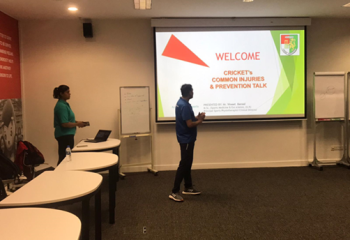Participating in sports or any other physical activity is a great way to keep your body active and maintain a healthy lifestyle. It holds plenty of benefits, ranging from controlling your weight to reducing the risk of disease. However, the risk of getting hurt or injured will always be present. But, fret not! There are ways that you can prevent these injuries or reduce the risk of getting them. With the best sports therapist, you can learn more about sports injury, rehabilitation, and sports psychology.
Causes Of Sports Injuries
Overuse
When you have an active lifestyle or play sports on a regular basis, the risk of getting sports injury or hurt is higher due to the muscles being overused. When you constantly train one part of your body without adequate rest or recovery time, it can cause stress, pain, and swelling, eventually resulting in injury.
Insufficient Warm Up
Prepping your body by warming up is a crucial step to take before starting any physical activity. However, many tend to disregard the importance of it and jump straight into their routine. Warming up helps prepare the body for exercise by gradually improving blood flow, allowing the muscles to contract and relax more easily, reducing the chance of strain. It also enables you to perform more vigorous activities with ease. When you skip this step, your body is much more prone to sprains, cramps, and other injuries due to “cold” muscles.
Overtraining
While playing sports and being active have their own benefits, doing too much can take a toll on your body, especially when you do not let your muscles rest and recover. Increasing the intensity and frequency of training adds additional pressure that your muscles can’t handle, breaking down your body even further.
Excessive Stretching
Stretching your muscles beyond their normal range can cause significant tears that cause more harm than good. Stretching should not be painful. If you feel a sharp or stabbing pain, it is a sign that you are overstretching. Overstretching can occur anywhere in the body but is most common in the knees, elbows, neck, fingers, ankles, and shoulders.
Incorrect Technique
Improper technique poses a greater risk of injury. When you perform the same movement repeatedly while using the wrong technique, it causes unnecessary stress on the muscles, leading to a potential injury—tennis elbow, for example, is often caused by having poor backhand technique.
Common Sports Injuries
Different sports can cause different injuries. Here are some of the most common injuries that many experience:
Anterior Cruciate Ligament (ACL) Rupture
The ACL is one of the key ligaments that helps provide stability. The knee endures a lot of impact and wear during sports activities, which is why tears are pretty common. The ACL can rupture when performing either contact or non-contact sports, causing it to swell, feel unstable, and become too excruciating to carry your weight.
Shoulder Strain And Tendon Tear
The rotator cuff is a group of muscles and tendons that surround the shoulder joint and help with movement and stabilizing the shoulder. These muscles may be torn when they are forcibly contracted and overstretched. One of the most common shoulder strain injuries is a rotator cuff tear. Athletes that play overhead sports, such as volleyball or tennis, have a greater risk of getting this injury due to the nature of the game.
Sprains
Sprains are commonly caused by a tear or overstretching of one or more ligaments. When these ligaments are injured, your joint will move in an unnatural way and may cause some tenderness, swelling, and bruising. One of the most common sprains is an ankle sprain. Some causes include walking on uneven surfaces or stepping on an object. Sprains can also occur on the back, knees, hips, and even thumbs.
Strains
A strain occurs when the muscles and tendons in the body are tensed too much, causing them to overstretch or result in a tear. When this happens, your movements in the affected area are very limited. Hip and calf strains are common injuries that athletes face.
Hamstring Pull
The hamstring consists of three muscles that run down the back of the leg, from the thighs to the knee. A hamstring pull occurs when these muscles are overstretched or torn. You may experience pain in the back of your thigh when straightening or bending, as well as swelling, bruising, and tenderness.
Shin Splints
Shin splints occur due to constant stress on the shin bone and muscles surrounding it, causing inflammation. This is fairly common among distance runners. Stretching and even wearing good running shoes are a couple of ways to prevent shin splints from happening.
Lower Back Pain
Wrist Injuries
Lower back pain is a common sports injury that athletes experience. Inflammation of back muscles due to strain and stiffness in the spinal joints can cause back pain and loss of movement. Proper warm-up and stretching are great ways to prevent this from happening.
The wrist comprises ligaments and tendons that provide stability. A wrist injury happens when these structures are contracted in a stretched position. Tennis players, golfers, and mountain climbers are more prone to this type of injury.

Prevention Is Key
- Always warm up and stretch thoroughly to increase the blood flow to your muscles. Do it gently and slowly so as not to overstretch yourself.
- Use appropriate attire that is made specifically for the sport of your choice so that you can perform it comfortably.
- Stay hydrated. Drink plenty of water before, during, and after your exercise or physical activity. Water helps to regulate your body temperature as well as reduce heat stress.
- Do not exert yourself beyond your level of fitness. Gradually increase the intensity and duration of training.
- Cross-train with other sports to ensure overall fitness and muscle strength.
- Use good and proper technique to avoid getting injured.
- Make sure that you stretch slowly, gently, and for a long time after any physical activity.
- Allow adequate recovery time and rest in between sports.
Avoiding or reducing the risk of sports injuries is easy with these simple steps:
Treating Your Sports Injuries
Some sports injuries may not be as severe as others and can be treated at home by following this R.I.C.E. method:
Rest
Stop any activity and let the injured area rest as much as possible. Keep it supported and avoid putting any pressure or weight on it for 24–48 hours.
Ice
As ice helps with swelling and pain, apply an ice pack to the injured area for 15 minutes every 2 hours. Do this during the first 48 hours of the injury.
Compression
Wrap the injured area with a firm elastic bandage to reduce the swelling and pain. Ensure that it is a snug fit but not too tight so that it does not restrict the blood flow.
Elevate
Raise the injured area, possibly above the level of your heart, to reduce pain and swelling. You can do so by propping a couple of pillows below the affected area.
Prevention Is Key
- Always warm up and stretch thoroughly to increase the blood flow to your muscles. Do it gently and slowly so as not to overstretch yourself.
- Use appropriate attire that is made specifically for the sport of your choice so that you can perform it comfortably.
- Stay hydrated. Drink plenty of water before, during, and after your exercise or physical activity. Water helps to regulate your body temperature as well as reduce heat stress.
- Do not exert yourself beyond your level of fitness. Gradually increase the intensity and duration of training.
- Cross-train with other sports to ensure overall fitness and muscle strength.
- Use good and proper technique to avoid getting injured.
- Make sure that you stretch slowly, gently, and for a long time after any physical activity.
- Allow adequate recovery time and rest in between sports.
Avoiding or reducing the risk of sports injuries is easy with these simple steps:
Seek Medical Attention
If you’ve followed the R.I.C.E. method but there are still signs of pain and swelling after 48 hours, it is best to seek medical help immediately. If your injury is improving but not to its maximum capacity, you can seek a physiotherapist! Your physiotherapist can help to rehabilitate the injured area and tailor an exercise program to improve your strength and flexibility.
With proper care and patience, you’ll be back in shape in no time!









Leave a reply